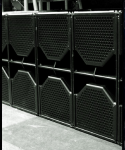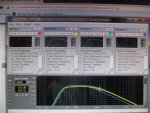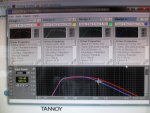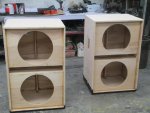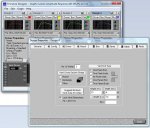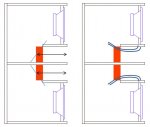Re: No compromises front loaded double 18” cab
Wow, there are some great suggestions here. It would seem by consensus that I should be looking in the direction of B&C. Lets take a look at the 18SW100 or the 18SW115.
1)I know I said no compromises, but in the real world we do have to worry about things like the cost of drivers and more costly still Amplifier power. If the 100 os more efficient then maybe it will work better for me.
2)What am I loosing by going with the 100 over the 115?
3)What about Dampening material, I have used the recycled denim material in the past, It works, but I don't know that it is the best thing out there.
4)What has everyone else used, and if there is something that you like can you recommend a good source for it?
5)how much dampening do I need?
1) If you are worried about cost, you should be looking at tapped horn designs, which can use half the drivers, power, and speaker cord for the same output, though at a slight increase in truck space over BR. When you consider only half the amps and cabling are needed, the space difference is not much (if any), but the cost goes down by 1/2 (sorry, Bennett and other driver, amplifier, and cord companies). Also, the cooling vent is exposed to the outside air in TH designs, so thermal compression, which is remarkably low for the B&C woofers, is reduced even more, further offsetting the slight space increase. Port compression is eliminated. The only downside is TH have to be explained to those who have simply specified "X number of 2x18".
One of my Keystone Subs (plans are available online) can put out as much SPL as four Meyers 2x18" HP 650, but some people have to hear it before they believe it, and they won't hear it since they don't believe one BC18SW115-4 (also used in DSL's TH-118, though the spec sheets still depict the 18Sound drivers originally used..) in a single cabinet could possibly keep up with 8 (pathetic by today's standards) sub drivers. Glad I have retired from the business of "selling sound by the pound" ;^).
2) 15 mm of coil diameter, while gaining some sensitivity. As Bennett mentioned, if you are not "beating the hell out of it", ie running within specifications, not too much reason to go with the 18SW115 (other than weight reduction) in a BR. That said, the 18SW115 can hold up to the abuse of a high compression ratio horn load will require better than the 18SW100.
3) Neither do I, but I don't like any type of organic (hemp, denim, jute, etc.) moisture retaining, mold and mildew harboring stuffing in my cabinets, and I live in the high desert where humidity is low. If you expect to operate in humid environments, forget about organic damping unless you and your clients like the smell of rotting vegetables.
4) Fiberglass insulation, readily available at any building store, I choose which ever is closer or offers a better price. Polyfill (like used in pillows, available in fabric stores and at inflated prices from speaker supply companies) is the more "politically correct" filler, but doesn't work as well, requiring more to do less.
5) None, damping material wastes power and reduces SPL, and retains heat, causing power compression to rise. Damping is used in "Full range" BR cabinets to avoid reflected upper waves from coming out the phase inversion (BR) ports causing ragged (and hollow sounding) response due to not being in phase with the output of the cone's front radiation phase. Sub woofers are cut off below port resonance frequencies rear their nasty little head(s).
Art

